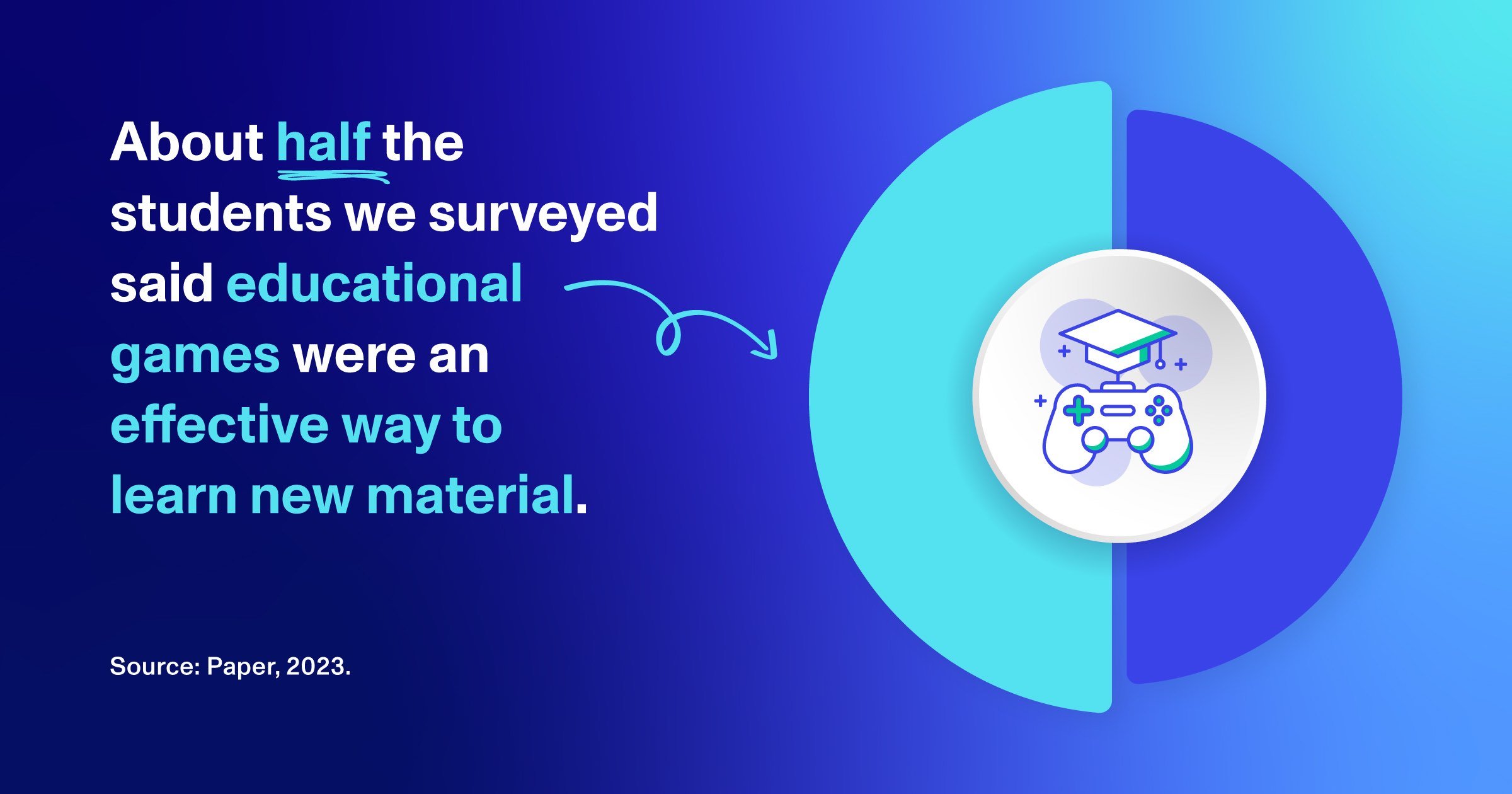
Game-based learning in education: A quick history
No matter what role you play in education, you’re likely no stranger to the buzz surrounding gaming. It seems like no matter where you turn, students are trying out new games, customizing their avatars, or launching friendly competitions with one another.
However, this rise in gaming doesn’t have to come at the expense of learning. And in truth, enterprising creators in the education industry have worked for decades to combine learning with all the fun and engagement great games provide.
First, what is game-based learning?
According to research compiled in an Educational Psychologist article about the foundations of game-based learning in education, this term refers to “a type of gameplay with defined learning outcomes.” However, authors Jan L. Plass, Bruce D. Homer, and Charles K. Kinzer also note that the design process of these educational games necessitates balancing the subject matter itself with the aim of creating an enjoyable gaming experience.
The popularity of gaming also speaks for itself. Roughly three-quarters of U.S. kids play video games, and around 7 in 10 K-8 teachers report incorporating digital game-based learning in the classroom. Likewise, proprietary research from Paper™ notes that 48% of students surveyed say they believe playing an educational game would be an effective approach to learning.

[READ: “The K-12 guide to game-based learning”]
When implemented thoughtfully, games and education make a great match. It’s no longer a question of whether games belong in educational contexts, but how to mindfully implement them.
The origins of education and gaming
Game-based learning has a long and storied history. Authors of a research paper on game-based learning note that strategy-heavy board games—xiangqi, mancala, and chess, to name a few examples—have been played for thousands of years, helping players sharpen their mental skills while providing entertainment and a chance for camaraderie. At the same time, ancient Greeks and Romans understood games and play-based learning as effective didactic tools.
Besides this, psychologists have long lauded the benefits of play and games in both cognitive development and learning. Roughly six decades ago, Jean Piaget—perhaps the most well-known developmental psychologist—famously described play as being intertwined with cognitive development in children, according to the previously mentioned article by Plass, Homer, and Kinzer.
Gaming’s digital evolution
With all of this in mind, we can view game-based learning in education as a more modern evolution of the older and widely accepted concept of play in pedagogical settings.
Plass, Homer, and Kinzer also note that today, there’s more interest in how, exactly, video games apply to the learning process. They then mention Geoffrey and Elizabeth Loftus’ “Mind at Play,” one of the first books about video game psychology.
By drawing on earlier research to home in on what makes video games engaging, Loftus and Loftus found that great games don’t dole out rewards so often that novelty wears out. At the same time, these games find their players’ learning edge: the delicate balance between a task being too easy and frustratingly difficult.
To be sure, Loftus and Loftus published this insightful analysis of video game psychology four decades ago. Regardless, their insights track with today’s most popular games, even though these titles are a world away from the more emergent video game options of the 20th century.
A recent timeline of game-based learning in education
Education and gaming have an incredibly rich history that can’t be accurately summarized in a short timeline. Below, we outline some of the most impactful moments in the history of game-based learning across the 20th and 21st centuries, but this is by no means an exhaustive list.
An important disclaimer
Additionally, we want to recognize that even though the following game titles are integral to telling this story, some of them contain problematic, antiquated depictions of their characters and cultural contexts. This is especially true with history-based computer games, perhaps the most well-known example being The Oregon Trail.
Paper does not endorse the contents of the game titles below, but we find it useful to mention them as key players in this decadeslong history.
1960s: The digital game-based learning market’s humble beginnings
- 1964: You might not believe it at first, but The Sumerian Game—recognized as the first educational computer game—paved the way for the rich and complex video games so many students enjoy today. Designed by Mabel Addis, a writer, teacher, and the first female video game designer, The Sumerian Game was created as part of a study featured in Computerworld magazine. The game served as a strategic exercise for students while also covering the history of ancient Sumer. To play, students would use an IBM terminal connected to a mainframe computer and slide projector, listening to a cassette track describing the contents of the slideshow in order to make their strategic decisions.
- 1966: The programming language Logo is created by computer scientists Seymour Papert, Wallace Feurzeig, Daniel Bobrow, and Cynthia Solomon. By using a cursor called a “turtle,” learners could direct a physical robot to move via lines created in pieces of code. The physical robot eventually became a computer program, and Logo was implemented in the classroom to teach students programming basics.
1970s: Students grow familiar with computer games
- 1971: The Oregon Trail—an educational computer game that would eventually be enjoyed across multiple generations—is developed by teachers Don Rawitsch, Bill Heinemann, and Paul Dillenberger. To play the game, students lead an 1800s-era pioneer wagon from Missouri to Oregon, encountering many tasks and pitfalls along the way. After its release in 1974, the game sees unprecedented success, becoming a staple in early computer labs. The game later launches updated versions with more sensitively informed depictions of Indigenous characters and westward expansion by white colonists.
- 1973: Minnesota’s government, in partnership with the University of Minnesota, launches the Minnesota Educational Computing Consortium (MECC). Over the following years, the MECC is integral in the creation and popularization of many influential learning-oriented computer games—including Odell Lake and Number Munchers. To combine the games holistically with more traditional teaching methods, the MECC provides materials such as worksheets that teachers can use in tandem with the games themselves.
- 1977: The Apple II, an 8-bit computer meant for home use, becomes one of the very first widely distributed microcomputers. Households and schools that own the Apple II are now able to play games via floppy disks, including some earlier educational games developed to be compatible with the system.
1980s: An explosion of mainstream learning games
- 1983: Sony and Phillips launch the CD-ROM, which allots more storage than the previous standard: floppy disks. With this increase in storage space, game developers can improve the graphics they use in games and enhance the gameplay experience overall.
- 1984: The Learning Company launches Reader Rabbit, a game teaching younger audiences how to read and spell with help from a rabbit host. Like the Carmen Sandiego game line mentioned later, Reader Rabbit grows to become one of the biggest success stories in educational gaming, launching spinoffs for decades.
- 1985: Game developer Brøderbund launches Where in the World is Carmen Sandiego? in the hopes of making geography more engaging. Players attempt to solve crimes by virtually traveling the world to try and find the game’s namesake, Carmen Sandiego. Although sales are slow at first, the game goes on to become one of the bestselling educational games of all time. Today, the game line is still launching new versions and partnerships, including a Carmen Sandiego crossover with Google Earth.
1990s: The internet turns gaming on its head
- 1991: Programmer and game designer Sid Meier launches Civilization, an iconic history- and strategy-heavy computer game. “Civ”—the nickname of the series adopted by gamers—“turns all of human history into a playground that you can exploit, turn by turn, to bring your chosen nation to glory,” writes Fraser Brown in PC Gamer. Beyond simply being an enjoyable game, Civ is an interactive way to learn about all things social studies.
- 1993: By launching code for the world’s first web browser and editor, English computer scientist Tim Berners-Lee puts the World Wide Web within the public’s reach. Of course, besides forever shifting the way we share and publish information, the internet also changes how students can access games and learn together.
- 1999: Inventor and entrepreneur Jim Marggraff launches the LeapPad—a sort of hybrid between a talking book and an educational game console for young children. In the early aughts, countless children in American homes learn with help from this bestselling item.
2000s: In a new tech era, educational games diversify
- 2005: Nintendo’s Brain Age game series launches and is one of the world’s first commercial neuroscience games. The original version of the game is for Nintendo’s handheld DS console and encourages players to complete puzzles, memorization games, and similar tasks that challenge their brains.
- 2006: Roblox, a game platform allowing users to program their own games and play those created by others, goes live. When it comes to gaming in the classroom, older students can use Roblox Studio to develop more in-depth games with help from code. An article about Roblox published by The Verge notes that more than half of U.S. children 16 and under play Roblox as of 2020.
- 2007: The programming language Scratch is developed, allowing learners to code their very own stories, games, and animations. As a free and open-source programming opportunity, Scratch still benefits hundreds of millions of young children annually.
[READ: “4 effective self-directed learning strategies”]
2010s: The rise of social gaming moments and massively multiplayer online games (MMOGs)
- 2011: Math Blaster, a classic edutainment video game first released in 1983, comes full circle with an online MMOG offering. Players using the game’s more updated version guide their space cadets and defend the universe—solidifying key math concepts all the while. At the same time, the multiplayer element of this new game helps players sharpen their social skills, showcase their rewards, and personalize their characters.
- 2011: The multiplayer sandbox game Minecraft launches, allowing users to gather resources and create their own immersive worlds and structures. Minecraft: Education Edition, its learning-specific offering, allows users to flex their ingenuity, teamwork, and problem-solving skills in a highly creative digital environment.
Peeking into the 2020s
Technological innovations such as touch screens and mobile applications create an entirely new ecosystem for game developers to benefit from.
Countless mobile app offerings are now downloaded and loved by both students and adults alike. One great example is the ever-popular language-learning app Duolingo, which allows anyone to become a polyglot with help from the brand’s owl mascot. At the same time, game developers are putting a fresh spin on older titles—a new version of The Oregon Trail among them—by translating these games into updated mobile-friendly versions that can be enjoyed by younger generations of gamers.
With so many education-oriented gaming options available, trying to wrap your head around game-based learning can be overwhelming. Our K-12 guide to game-based learning is here to help.

![3 ways game elements can drive educational engagement [Infographic]](https://paper.co/hs-fs/hubfs/Paper-Blog_3-ways-game-elements-can-drive-educational-engagement.jpg?width=260&height=136&name=Paper-Blog_3-ways-game-elements-can-drive-educational-engagement.jpg)




